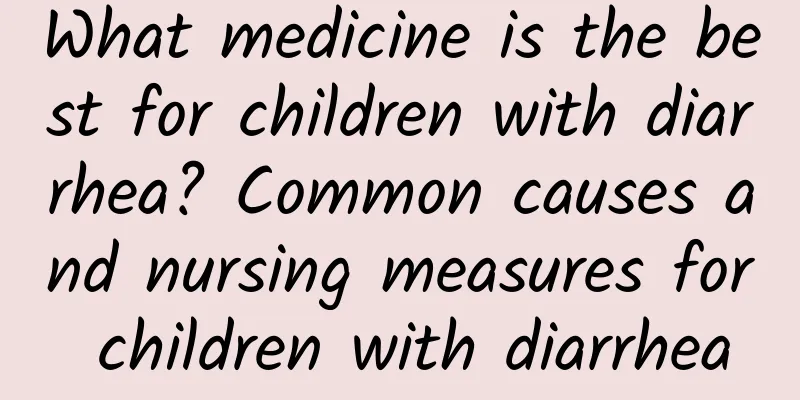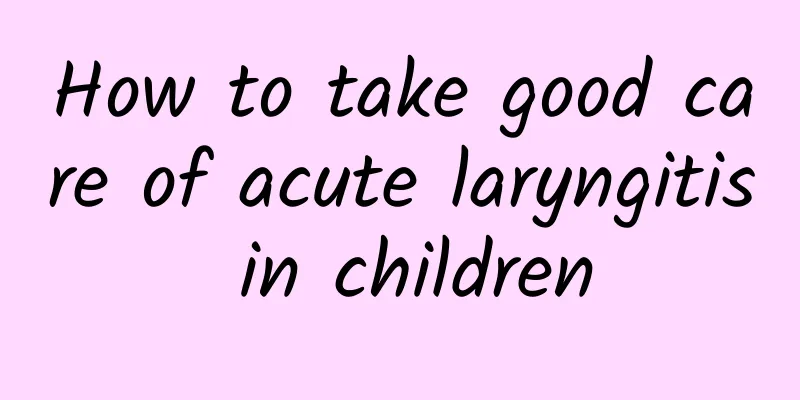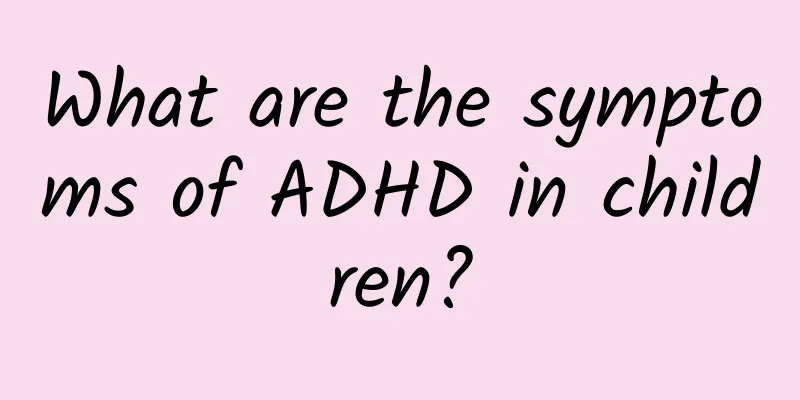What medicine is the best for children with diarrhea? Common causes and nursing measures for children with diarrhea

|
Before the cause is identified, changes in stool characteristics and an increase in the number of bowel movements are collectively referred to as diarrheal disease. Diarrhea is a group of diseases caused by multiple causes and factors. It is one of the diseases with the highest incidence in childhood and a global public health problem. At least 1 billion people suffer from diarrhea each year worldwide. According to a survey by the World Health Organization, about 10,000 people die from diarrhea every day. In my country, diarrheal disease is also a common disease among children. According to relevant data, the annual incidence of diarrheal disease in children under 5 years old in my country is 201%, with an average of 3.5 cases per child per year and a mortality rate of 0.51%. Therefore, the prevention and treatment of diarrheal disease in children is very important. 1. Diarrhea stages 1. Acute diarrhea lasts less than 2 weeks. 2. Persistent diarrhea lasting from 2 weeks to 2 months. 3. Chronic diarrhea lasting for more than 2 months. 2. Diarrhea classification 1. Diarrhea: It is divided into two types according to the severity: mild (simple diarrhea) and severe (toxic diarrhea). (1) Mild diarrhea: mostly caused by dietary factors or extraintestinal infection, or caused by intestinal viruses or non-invasive bacteria. Mainly gastrointestinal symptoms, the number of bowel movements per day is usually less than 10 times, and in a few cases it can reach more than ten times. The amount of stool each time is not much, thin or watery, yellow, and sour. White or yellowish-white milk curds (soap blocks) and foam are common, and may be mixed with a small amount of mucus. Generally, there is no fever or the fever is not high, accompanied by loss of appetite, occasional galactorrhea or vomiting, no obvious systemic symptoms, good spirits, no dehydration symptoms, and most patients recover within a few days. (2) Severe diarrhea is often caused by intestinal infection 1) Gastrointestinal symptoms: frequent diarrhea, 10 to 30 times per day or more, with more water and less stool, or more watery stool mixed with mucus, accompanied by abdominal distension and vomiting. 2) Dehydration: The degree of dehydration is divided into mild, moderate and severe. The nature of dehydration is divided into isotonic, hypotonic and hypertonic. Diarrhea in children is determined by their physiological characteristics. First, because the gastrointestinal tract of children is not fully developed, there is less stomach acid and poor sterilization ability. If they eat and drink too much in summer, the stomach acid will be diluted, making it easy for bacteria to pass through the stomach acid barrier and enter the intestines to cause diarrhea. Secondly, there are few digestive enzymes in the gastrointestinal tract of children, which is not conducive to food digestion and can easily cause indigestion. Thirdly, infants and young children grow rapidly and need sufficient nutrition. The burden on the gastrointestinal tract of children is relatively heavy, and digestive disorders are prone to occur. In addition, the high temperature in summer makes it easy for bacteria to multiply, which is also one of the reasons for the increase in infection. Pay attention to food hygiene: Strengthen health education and strictly manage water and food hygiene. Food should be fresh and clean. Any spoiled food should not be fed to children, and eating utensils must also be disinfected. Breastfeeding is recommended. Breast milk is the most suitable food for infants under six months old, and feeding on demand should be strongly recommended for infants. Human milk contains IgA, which can neutralize E. coli enterotoxin and prevent infection with E. coli. Add complementary food on time: When adding complementary food to children, you must pay attention to starting from less to more, gradually increasing it so that the baby has an adaptation process; from thin to thick, first drink rice soup, gradually transition to porridge and soft rice; from fine to coarse, such as when adding fruit, start to feed juice, and then eat fruit puree. Try adding egg yolk, fish puree, and soft tofu at five months; after seven months, you can add nutritious food that is suitable for digestion and absorption, such as fish, minced meat, vegetables, biscuits, etc., and gradually make some necessary preparations for weaning, but weaning in the summer should be avoided. When gradually adding food, it is best to get used to one food before adding another, and not to add several at the same time. If the child is sick, another food should not be added temporarily. When the child has a poor appetite, it is not advisable to force feeding. Strengthen physical fitness: You should increase outdoor activities, improve the ability to adapt to the natural environment, pay attention to physical exercise for children, strengthen their physical fitness, improve the body's resistance, and avoid infection with various diseases. Avoid adverse stimulation: Children should prevent excessive fatigue, fright or excessive mental stress in their daily lives. Strengthen the care of weak infants and young children: Children with malnutrition, rickets and those who are weak after illness should be cared for more, pay attention to food hygiene and avoid various infections. Mild diarrhea should be treated in time to avoid delaying and becoming severe diarrhea. Avoid cross infection: Infectious diarrhea can easily lead to an epidemic. Newborns, childcare institutions and hospitals should pay attention to disinfection and isolation. Children with diarrhea and carriers should be isolated and treated, and dried stools should be disinfected. Reasonable use of antibiotics: Avoid long-term abuse of broad-spectrum antibiotics to prevent intestinal flora imbalance, which may lead to the growth of drug-resistant bacteria and cause enteritis. The treatment principles for diarrheal diseases are ① prevention of dehydration; ② correction of dehydration; ③ continued diet; ④ rational use of medication. According to the above principles, children with mild symptoms and no obvious dehydration can take the following measures for home treatment. Severe cases require hospital treatment. 1. The child should drink enough fluids orally to prevent dehydration. The following liquids are available: ① Rice soup plus salt solution: Preparation method: 500ml rice soup (1 jin wine bottle) + 1.75g fine salt (half of a flat beer bottle cap); or 25g fried rice noodles (about two full porcelain spoons) + 1.75g fine salt (half of a flat beer bottle cap) + 500ml water and cook for 2-3 minutes. To prevent dehydration: First give 20-40ml/kg, small amounts and multiple times orally, take it within 4 hours, and take it orally at any time afterwards, as much as you can drink. ② Sugar and salt water: Preparation method: 500ml boiled water (1 jin bottle) + 10g sucrose (2 teaspoons) + 1.75g fine salt (half of a flat beer bottle cap). Dosage and administration method are the same as above. ③ Oral rehydration salt (ORS) solution (use with caution for newborns), for children under 10 years old, give as much ORS solution as they can drink, and 2000ml of ORS solution should be provided every day. It is advisable to feed in small amounts and multiple times. Children under 2 years old can be fed 1 teaspoon (about 5ml) every 1 to 2 minutes; older children can drink directly from a cup. If the child vomits, stop for 10 minutes and then feed the child slowly (one spoonful every 2 to 3 minutes); if diarrhea does not stop after the ORS solution is used up, feed the child some of the liquids mentioned in the above principles or see a doctor. 2. Give the child enough food to prevent malnutrition Breastfed children should continue to be breastfed, and the interval between feedings can be appropriately extended. If the child is not breastfed and is under 6 months old, the child can continue to be fed with milk or dairy products that the child consumes daily. Dilute milk (or goat's milk) with an equal amount of rice soup or water, and gradually resume normal diet after the diarrhea improves. Yogurt or a milk-cereal mixture can also be used. If conditions permit, lactose-free milk powder can be replaced. If the child is over 6 months old, give him the usual diet he is accustomed to, such as porridge, noodles or soft rice, vegetables, fish or minced meat, etc., starting from small amounts to large amounts. An appropriate amount of fresh fruit juice or fruit can be given to supplement potassium. These foods should be well cooked, ground or mashed to make them easy to digest. Older children can eat nutritious and easily digestible foods, and avoid greasy foods. 3. Optional drugs: ① Microecological regulation preparations: The purpose is to restore the normal intestinal flora and rebuild the natural biological barrier protection of the intestine. Commonly used ones include Bifidobacterium, Lactobacillus acidophilus and Streptococcus faecalis. ② Intestinal mucosal protection preparations: adsorb pathogens, maintain the normal absorption and secretion function of intestinal cells; interact with intestinal mucus glycoproteins to enhance its barrier function to prevent the attack of pathogenic microorganisms. Such as Smecta. 4. If the child does not get better within 3 days, or if any of the following symptoms occur within 3 days, the child should seek medical attention: increased frequency and amount of diarrhea; inability to eat normally; frequent vomiting; fever; obvious thirst; blood in the stool should: 1. It is advisable to eat foods that do not contain lactose; 2. It is advisable to eat non-sweet food; 3. Eat light food. avoid: 1. Avoid eating high-fiber foods; 2. Avoid eating foods containing fat; 3. Avoid eating foods containing sugar. |
<<: What is tics? What are the causes of tics?
>>: What are the common causes of colds in children? How to identify the type of cold in children?
Recommend
How to diagnose diarrhea in children
Pediatric diarrhea is a very common disease that ...
About the causes of childhood kidney disease
The cause of childhood kidney disease is a group ...
What to do after pneumonia in children
Are you still looking for medical advice for your...
How to treat jaundice in children
How to treat jaundice in children? The treatment ...
How to treat mycoplasma cough in children
Mycoplasma cough in children can generally be tre...
How to treat a child with a cough and fever? What is the most effective way to treat a child with a cough and fever?
It is normal for children to have coughs and feve...
How to prevent Kawasaki disease through lifestyle habits
We must take preventive measures in our lives so ...
Symptoms of ADHD in 2-month-old babies
Symptoms of ADHD in 2-month-old babies usually in...
Common home care for patients with phenylketonuria
Do you know the common home care for patients wit...
How to prevent jaundice in newborns? Pay attention to these when preventing jaundice in newborns
To prevent neonatal jaundice, the baby must be br...
Chinese medicine diet therapy and modern nutrition are two different things
In layman's terms, Chinese diet therapy is a ...
What to do if children have high jaundice
What should I do if my child has high jaundice? T...
How to cure diarrhea in children
Because children have weak resistance, they are o...
Should I stop breastfeeding if my newborn has jaundice?
As long as the baby grows normally, eats normally...
Does ADHD require medication?
Do children with ADHD need medication? In the pas...









